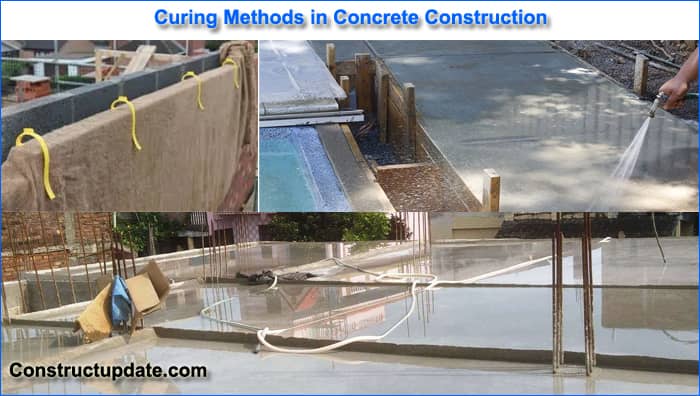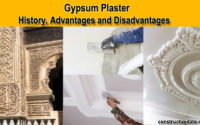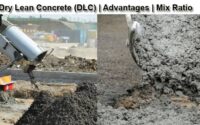Concrete Curing Methods – Non-Conventional Methods of Concrete Construction Curing
Cement, which holds all of the other elements of concrete together, is the primary component of concrete. Water and cement interact and become bonded. Yet, it produces a lot of heat as it reacts with the water. The heat of hydration is another name for this heat produced by concrete.
Heat of Hydration is primarily determined by the amount of Alite and Tri Calcium Aluminate present in cement, but it is also somewhat impacted by the ratio of water to cement, the fineness of the cement, and the curing temperature. Up until the concrete is fully functional, the hydration process continues. The fresh concrete that is curing is unaffected by this heat. Yet, the hydration process has an impact on the poured concrete after the initial hardening. Concrete’s strength will be decreased if this heat is not controlled.
Water is therefore necessary for concrete since it needs it to be hydrated when it hardens, which causes heat to be controlled. Curing is the procedure of supplying water to regulate hydration.
The concrete is cured using a variety of traditional and non-conventional curing techniques. As they must be used in specific situations and are very expensive, most unconventional procedures are not widely used. The traditional ways of curing have previously been covered. We’ll go over the non-conventional curing methods in this section.

1. Curing by Immersion Method
The best water-curing technique is this one. This procedure involves submerging a finished concrete element in a curing tank or pond. This results in the concrete meeting its moisture requirement. This technique is utilised for pre-cast concrete members that can be readily handled and placed in the curing tank for a predetermined amount of time, such as tiles and pavers.
This approach of absolute immersion is essentially impossible unless the concrete is in a small pre-cast unit or is being tested in a lab. This procedure requires more handling and labour.
2. Ponding of Water
When there is a convenient supply of good “dam” material (such as clay soil), and a supply of water, and the “pond” does not obstruct future building processes, ponding is a rapid, affordable, and efficient method of curing.
Via the creation of small ponds, pavement slabs, roof slabs, etc. are kept submerged in this way. It is the next widely used method for curing concrete and is best suited for horizontal surfaces like slabs, floors, and roadways.
By erecting transient barriers, little ponds that are no deeper than 5 cm can be created over the surface.
The water in these ponds is maintained there for several days. Ponding is the best way for curing concrete in hot weather. It also contributes to maintaining a constant temperature on the slab’s surface.
3. Wet Coverings
For the purpose of keeping the concrete moist, wet coverings like wet gunny bags, jute matting, and straw have occasionally been wrapped over vertical surfaces.
For horizontal surfaces, wet covers made of sawdust, soil, or sand are utilised to keep the concrete moist for a longer period of time.
After the formwork is removed, another technique that works well for horizontal, columnar, and vertical surfaces is to cover the area with straw, burlap, hessian, or jute that has been moistened. Throughout the entire curing process, these are maintained moist. Textiles are especially helpful on vertical surfaces because they assist spread water evenly throughout the surface and, even when they are not in contact with it, they will stop the concrete’s surface from evaporating and provide the extra water that is needed for hydration.
4. Electrical Curing
An alternating current is passed into concrete between two electrodes during electrical curing. The concrete either has these electrodes concealed or exposed. Care must be taken to prevent moisture from evaporating from the concrete and drying it off.
During working hours, this casting process is carried out, and after hours, an expedited curing procedure is carried out.
In places with a chilly environments, electric curing is frequently utilised. This is not a cost-effective course of action. There are skilled employees on hand, and ongoing supervision is necessary.
5. Infra-red Radiation Concrete Curing
Concrete’s temperature is raised by infrared radiation, giving it an immediate boost in strength. For curing hollow concrete goods like hollow concrete blocks, this technique is frequently utilised. An average working temperature of 90 o C is maintained.
Compared to steam curing, the strength may be increased quickly. Unlike steam curing at normal pressure, the initial high temperature has not reduced the strength.
6. Water Retention Method by Curing Compounds(Membrane Method)
In general, this might be referred to as the chemical process of curing concrete.
This procedure involves spraying some relevant chemical compounds that have been dissolved in solvents over freshly laid concrete. A thin layer of the chemical compound is spread across the concrete surface as the solvent evaporates.
This film prevents evaporation from the concrete.
As a result, concrete will set and harden properly without much more water if enough water was introduced when it was being prepared. After some time (2-4 weeks), the heavy layer of chemical components starts to peel off, leaving the perfectly cured concrete in its place. The majority of curing chemicals are made up of various resins.
The inability to perform continuous concreting using this technology is a significant drawback. If the chemical is not totally eliminated from the cured surface, it will not firmly connect with a new layer.
Importance of Curing of Concrete in a Construction
Concrete curing is one of the final and most crucial steps that must be completed during the construction process. The individuals participating in construction and those in charge of quality assurance must pay complete and careful attention to this final step since it is crucial to the performance of concrete.





